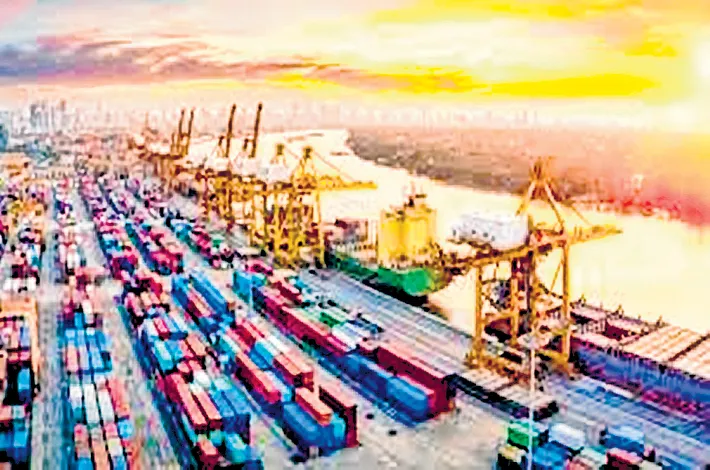From health crisis to economic pulldown : The cost of pollution
14-11-2025 12:00:00 AM

Delhi's air quality has plunged into toxic territory once again, triggering Stage 3 of the Graded Response Action Plan (GRAP-3). Construction activities have been halted, truck movements restricted, and daily business operations across the National Capital Region (NCR) severely disrupted. What was once viewed as a seasonal civic nuisance has evolved into a full-blown economic shock, impacting productivity, projects, and profits. A senior business journalist highlighted the escalating crisis, noting that pollution-related deaths and disabilities cost the Indian economy nearly 9.5% of GDP in 2023—equivalent to a staggering $339 billion.
What is GRAP 3.
Graded Response Action Plan – Stage 3 is the third level of a four-stage emergency action plan activated by the Commission for Air Quality Management (CAQM) in Delhi and the National Capital Region (NCR) when air quality turns “severe”. It consists of four escalating stages, each triggered by worsening Air Quality Index (AQI) levels. Under this, a wide range of construction and demolition activities are completely banned, except for critical national projects such as railways, metro rail, airports, hospitals, and sanitation initiatives. This halt aims to reduce dust and particulate matter, major contributors to winter smog in Delhi.
An estimated 1.7 million lives were prematurely lost to toxic air that year, with Delhi alone accounting for 15% of pollution-linked deaths. The economic toll extends far beyond the capital. States like Uttar Pradesh, Bihar, and Madhya Pradesh lost close to 2% of their GDP to air pollution in 2019, a figure likely higher today. In Delhi, the Chamber of Trade and Industry (CTI) estimated a Rs 2,500 crore blow to the local economy late last year under GRAP-4 measures, representing a 20% drop in business activity.
Daily footfalls plummeted, weddings and events were postponed, and supply chains faltered. A separate study revealed that air pollution inflicted Rs 7 lakh crore in losses on Indian businesses over just four months—nearly 43% of the impact seen during COVID-19 lockdowns. "Air pollution is not just killing people; it's hurting profits and productivity," the journalist emphasized, warning that India's growth momentum could be dampened if ignored.
Education takes a hit as schools shift online or close. Tutoring centers in East Delhi lose Rs 5,000 per student monthly. Parents juggle work and childcare, with one mother reporting her child's asthma attacks costing Rs 20,000 in medical bills during a single GRAP episode. Logistics companies like Delhivery reroute fleets, adding 200 km detours to avoid NCR bans.
Fuel costs surge 15%, delays erode customer trust. "E-commerce peaks during Diwali, but pollution curfews kill last-mile delivery," a operations head complained. Labor unions demand pollution bonuses. Construction workers exposed to dust seek hazard pay, with one union filing petitions for Rs 500 daily allowances during bans.
A noted environmentalist argued that the true costs are understated in GDP calculations. "When someone is hospitalized and pays bills, it actually adds to GDP growth," he pointed out, critiquing the perverse incentives. He stressed that premature deaths and illnesses impose unaccounted burdens on individuals and families, potentially exceeding quantified business losses. Businesses, he added, cannot function without healthy workers—productivity suffers when employees fall ill or are encouraged to flee Delhi during winter months, a luxury few can afford.
A senior office bearer at the Centre for Science and Environment, delved into industrial impacts. In the NCR, industries are barred from using coal, forcing a shift to costlier alternatives like natural gas or biomass. Compliance with mounting regulations demands in-house environmental teams and reporting, inflating operational expenses. Workers in small and medium-scale industries face year-round exposure without adequate pollution controls, he noted, underscoring how pollution raises costs for businesses and end-users alike while hindering the transition to a greener economy.
Another office bearer of the of the Confederation of All India Traders (CAIT), described how pollution curbs under GRAP have become an annual inevitability, baked into business planning. Construction halts, wholesale disruptions, and logistics snarls hit sectors hard. Businesses are adapting by factoring in these risks, but short-term resistance persists due to immediate cost hikes. He warned that in the long term, costs may rise further without action, calling for solutions to mitigate recurring shocks.
An economist observed that companies are beginning to incorporate environmental risks into project valuations and net present value estimates—though not uniformly. She pointed out that a decade ago, these hazards weren't priced in as much, citing examples like the NHPC hydropower project's massive losses from an Uttarakhand landslide. Delays, cost overruns, and non-compliance evade full penalties, while ESG reporting and risk disclosures remain inconsistent. She advocated for better integration of climate risks into financial statements to help investors price them accurately.
On the policy front, environmentalists seriously criticized a 25-year failure to address Delhi's winter smog, even as Parliament sessions expose lawmakers to the hazard. They expressed concern about a complete lack of vision at the highest levels, urging integration of natural resource accounting into national budgets to reflect true losses in GDP.
They also highlighted enforcement gaps: delayed SOx emission norms for thermal power plants, unreliable online monitoring data, and overburdened regulators struggling with thousands of small industries. They proposed innovative solutions like centralized boilers, drone monitoring, and common effluent treatment plants to ease compliance burdens.
The economists and industrial experts outlined fiscal implications, including rising healthcare costs, productivity losses, and natural resource depletion that strain state economies. They argued that policymakers must compensate for private-sector output shortfalls through increased spending, noting indirect GDP hits from reduced life expectancy, agricultural damage, and tourism declines. They urged India Inc. to petition the Prime Minister for effective implementation of initiatives like Swachh Bharat, while criticizing recent relaxations on flue gas desulphurization for power plants.
The consensus was clear: pollution is both an environmental and economic emergency. One key policy shift, panelists suggested, lies in streamlining compliances and boosting regulator capacity through technology. "Clean air must be seen not as compliance but as competitiveness," was the summary. With numbers underscoring the crisis, India cannot decouple its economic ambitions from environmental realities. The opportunity—for businesses and policymakers alike—is to prioritize resilience now, before the cyclical drag becomes irreversible.








